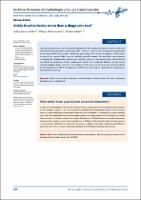Ankle-brachial index: more than a diagnostic test?

View/
Related Resource(s)
https://apcyccv.org.pe/index.php/apccc/article/view/168Date
2021-12-27Author(s)
Cáceres-Farfán, Ludwig
Moreno-Loaiza, Milagros
Samir Cubas, W.
Metadata
Show full item recordAlternate title
Índice tobillo-brazo: ¿algo más que una prueba diagnóstica?
Abstract
The ankle-brachial index (ABI) is the relationship between the systolic blood pressure taken at the ankle
level and the brachial artery. A pathological ABI (<0.90 or >1.40) indicates the presence of peripheral
artery disease (PAD). Many studies indicate the great utility of this test in the diagnosis of PAD due to
its ease of use, reproducibility, low cost, and high cost-effectiveness. This evaluation can be directly
correlated with cardiovascular morbidity and mortality; however, it has recently been confirmed that a
low ABI can be a predictor of major cardiovascular events, as it is related to diabetes mellitus, chronic
coronary disease, stroke, and more. The objective of this work was to review the current evidence
on the importance of ABI in the diagnosis of PAD and its main role as a predictor of cardiovascular
morbidity and mortality. El índice tobillo-brazo (ITB) es la relación entre la presión arterial sistólica tomada entre el tobillo y la arteria braquial.
Un ITB patológico (<0,90 o >1,40) indica la presencia de enfermedad arterial periférica (EAP). Muchos estudios
muestran la gran utilidad de esta prueba en el diagnóstico de la EAP debido a su facilidad de uso, reproducibilidad,
bajo coste y alta rentabilidad. Esta evaluación puede correlacionarse directamente con la morbilidad y mortalidad
cardiovascular; sin embargo, recientemente se ha confirmado que un ITB bajo puede ser un predictor de eventos
cardiovasculares mayores, ya que está relacionado con la diabetes mellitus, la enfermedad coronaria crónica y
el ictus, entre otros. El objetivo de este trabajo fue revisar la evidencia actual sobre la importancia del
Collections
- Artículos científicos [890]





